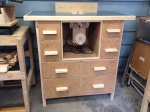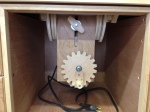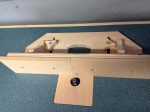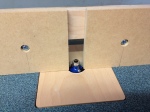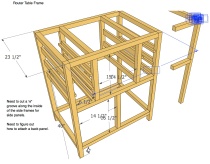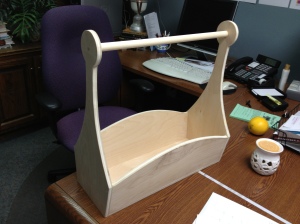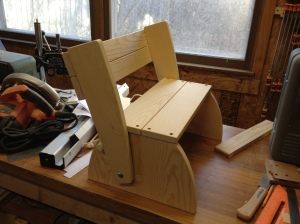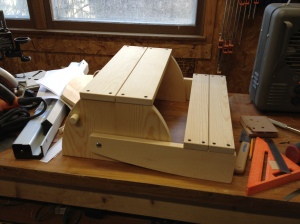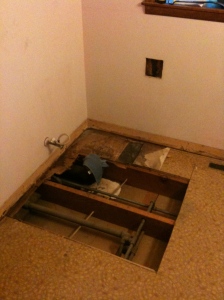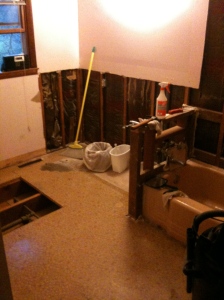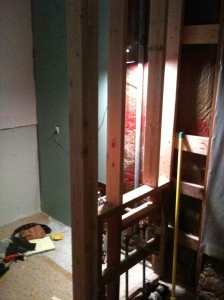At the Woodworking Show in Kansas City last month I found a pretty good deal on a Porter Cable 690 router–a pretty basic machine, but from what I gather, it’s a ubiquitous, fairly reliable workhorse of a router. I went to the show thinking I might look around for a good deal on a small trim router, like a Bosch Colt or one of the other similar models by other manufacturers, and there were a couple of deals on those. Maybe I’ll spring for a trim router one of these days, but I decided I didn’t really want to buy a set of 1/4″ bits (mine are all 1/2″ shanks), and it would be nice to have a reasonably hefty router installed in my router table all of the time. The PC690 is a 1.75-horsepower machine, which is just fine for the kind of routing I do at the table. It came with a fixed base, which is also fine, since I’ll be using it in the table. (My Bosch 1617 has fixed and plunge bases.)
A couple of months ago I decided I was going to build a new router table–mine is a simple little thing I knocked together with MDF and mounted on a Workmate. It has served me well for a couple of years, but I really need something with some dust-collection capability (even though I don’t yet own a DC), and with some storage built-in. My fantasy was to have a router lift, but I just couldn’t imagine spending $300-$400 on one. For some time I’ve admired Matthias Wandel’s router lift project, and the most recent version is a tilting lift, which makes a given bit useful in additional ways. It always seemed too ambitious for my skills and my modest shop, but now that I’ve got a band saw…
So when I got home from the Woodworking Show I immediately ordered a set of plans from woodgears.ca, and now it appears I’ve got a fun project on my hands. I’ve decided to build it with materials I already have in the shop–this means that instead of purchasing some Baltic birch plywood (which I can’t get locally, anyway), I’ll be using birch plywood leftover from my vanity project. I have a little bit of hard maple, but I’m saving it for a guitar neck, so I’ll be using river birch for the hardwood parts (also left over from my vanity project). There’s some hardware to buy, but that’s not too expensive. I figure that if I use the wood I have on hand, I’m not really out anything except the cost of the plans and the cost of the hardware. If I decide that I really need nicer materials, I can always build it again later.
The slide mechanism
I started by cutting a couple of pieces of 3/4″ plywood for the sliding router motor carrier mechanism, and some hardwood strips for the runners. I also cut out the two gears from 1/2″ birch ply, and my preliminary tests indicate that they should work pretty well (although they’re a little rough, as it was my first time to cut wooden gears). I believe this speaks very highly of Matthias’ design. (Pictures will be posted soon.) I had to make a minor modification to the router mount for my particular router motor, but I think it’s going to work out just fine.
The plans call for a plastic knob for locking the sliding carriage in place, but knobs are so expensive I decided to just make one from a scrap of maple and a hex nut, and so far it’s working great. This design uses a couple of ball bearings–one for the main gear and one for the lifting shaft. My local hardware store didn’t have the right size, but I would have paid up to $4 or so each if they had had them in stock. But when I saw that they’re price was more like $12-13 each, I decided I’d find another way. I went to a local skate shop and asked if they had skate bearings, because Matthias got his from old inline skates. Although the guy at the shop didn’t really know much about them, and I didn’t have a metric ruler on me (nor did he), I decided to take a chance. These bearings were only available in packs of eight–for $11. So I gladly did that deal.
Except for the hinges, I pretty much bought all of the hardware specified–I figured even if I had some of it on hand, it would take me a lot less time and cost me less frustration to just go get the specific things I needed. I spent about $41 on hardware, including the bearings, but those costs include two boxes of different sizes of drywall screws, at about $6.50/box, and I only need a small handful of each size for this project. And as I said, I didn’t need all eight of those bearings. So I’m going to estimate that I’ve got about $20 invested in the hardware, at most. Given that all of the wood I’m using is scraps, including pretty much everything I’ll be using to build a new router table, that’s a really good investment.
More info (and photos) as the project progresses.
